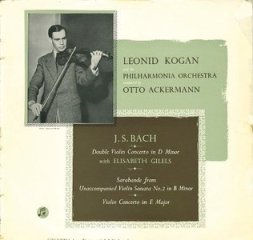The Art Of Leonid Kogan (2014) CD2 Bach Violin Concertos - Sarabande
The Art Of Leonid Kogan (2014) CD2 Bach Violin Concertos - Sarabande

1. Bach Double Violin Concerto D BWV1043 - I. Vivace 3:59 2. Bach Double Violin Concerto D BWV1043 - II. Largo ma non tanto 6:40 3. Bach Double Violin Concerto D BWV1043 - III. Allegro 5:18 4. Bach Violin Concerto in E major BWV 1042 - I. Allegro 8:17 5. Bach Violin Concerto in E major BWV 1042 - II. Adagio 7:31 6. Bach Violin Concerto in E major BWV 1042 - III. Allegro assai 3:05 7. Bach Partita No.1 in Bm BWV 1002 – Sarabande 3:11 Leonid Kogan & Elizaveta Gilels(violin) Philharmonia Orchestra Otto Ackermann (conductor)
Concerto for Two Violins in D minor, BWV 1043, is often called the Bach Double and was composed by Johann Sebastian Bach (1685-1750). The precise date when this concerto was composed is unknown. Although it was originally thought that Bach composed this piece during the time when he was director of music for Prince Leopold of Anhalt at Cöthen (between 1717 and 1723), recent scholarship seems to indicate that Bach composed this concerto during his Leipzig period. Manuscript parts for Bach’s D minor concerto for two violins date approximately 1730-31, a time when Bach was not only the civic director of music for Leipzig (one of the most prestigious musical positions in Germany at the time), but he had also assumed leadership of Leipzig 's collegium musicum, a voluntary organization founded by Telemann in 1702. Members of Leipzig’s collegium musicum included university students and professional musicians, and they contributed to Leipzig’s musical culture with weekly concerts.
Bach’s D minor concerto is scored for two solo violins, continuo and strings, and follows the typical Baroque concerto pattern of three movements (fast-slow-fast). This particular arrangement has been simplified, and has been arranged for three instruments. Bach’s interplay between the soloists is exquisite as the melodies interweave each other in a continual stream of contrapuntal melodies. --- violinonline.com
Violin Concerto in E major BWV 1042. This work, along with Bach's other surviving violin concerto, was composed during his stint in the service of the Prince of Anhalt-Cöthen. J.N. Forkel, Bach's original biographer, describes the concerto as being "full of an unconquerable joy of life, that sings in the triumph of the first and last movements." By the time Bach composed this concerto he had long been familiar with Antonio Vivaldi's influential works in the same medium. In the concerto's scintillating and ebullient first movement (Allegro), Bach takes the basic idea of ritornello form (around which Vivaldi's and almost all other Baroque concertos are composed), employs the essential motivic processes involved in that kind of composition, and shapes the whole into a superb da capo-form dialogue between soloist and accompanying ripieno group in which neither has supremacy over the other. While a certain balance between the soloist and the accompaniment is maintained, the basic content of the movement, defined by a powerful arpeggiated triad motif (reminiscent of Vivaldi's violin concerto "Il favorito"), becomes a springboard for continuous invention and subtly virtuosic embellishment. In the central Adagio, a deeply mournful instrumental aria of unique beauty, the violin's intricate musings are woven in and around a quiet ostinato in the bass instruments. The Allegro assai rondo finale is a dance-like movement of an extraordinary exuberance. Each successive contrasting passage exploits the violin's bravura capabilities more and more, until at last the final refrain swoops in on the wings of wild thirty-second notes. The Harpsichord Concerto in D major, BWV 1054, is a transcription made by Bach, probably during the late 1730s, of this E major Violin Concerto. --- Blair Johnston, Rovi
Partita for solo violin No. 1 in B minor, BWV 1002 is structurally unusual among Bach's sonatas and partitas for solo instruments in that it consists of four pairs of movements, the second of each pair offering a variation (or, employing the French term double) on the first. The work is technically challenging, generally more difficult than the third partita but not as tough as the second, the famous Chaconne of which is clotted with double and triple stops.
The mood becomes somber with the Sarabande, the only movement in this partita to receive the French version of its title. Indeed, unlike the common Italian model, this French Sarabande is slow (in 3/4 meter) and expressive, its second half almost entirely in double stops. Its "Double" switches to 9/8 and increases the tempo, but the mood remains questioning and unsettled; at least Bach now eases off the multiple stops. --- James Reel, Rovi
download (mp3 @320 kbs):
yandex 4shared mega mediafire zalivalka cloudmailru oboom uplea
Zmieniony (Wtorek, 03 Listopad 2015 17:25)








